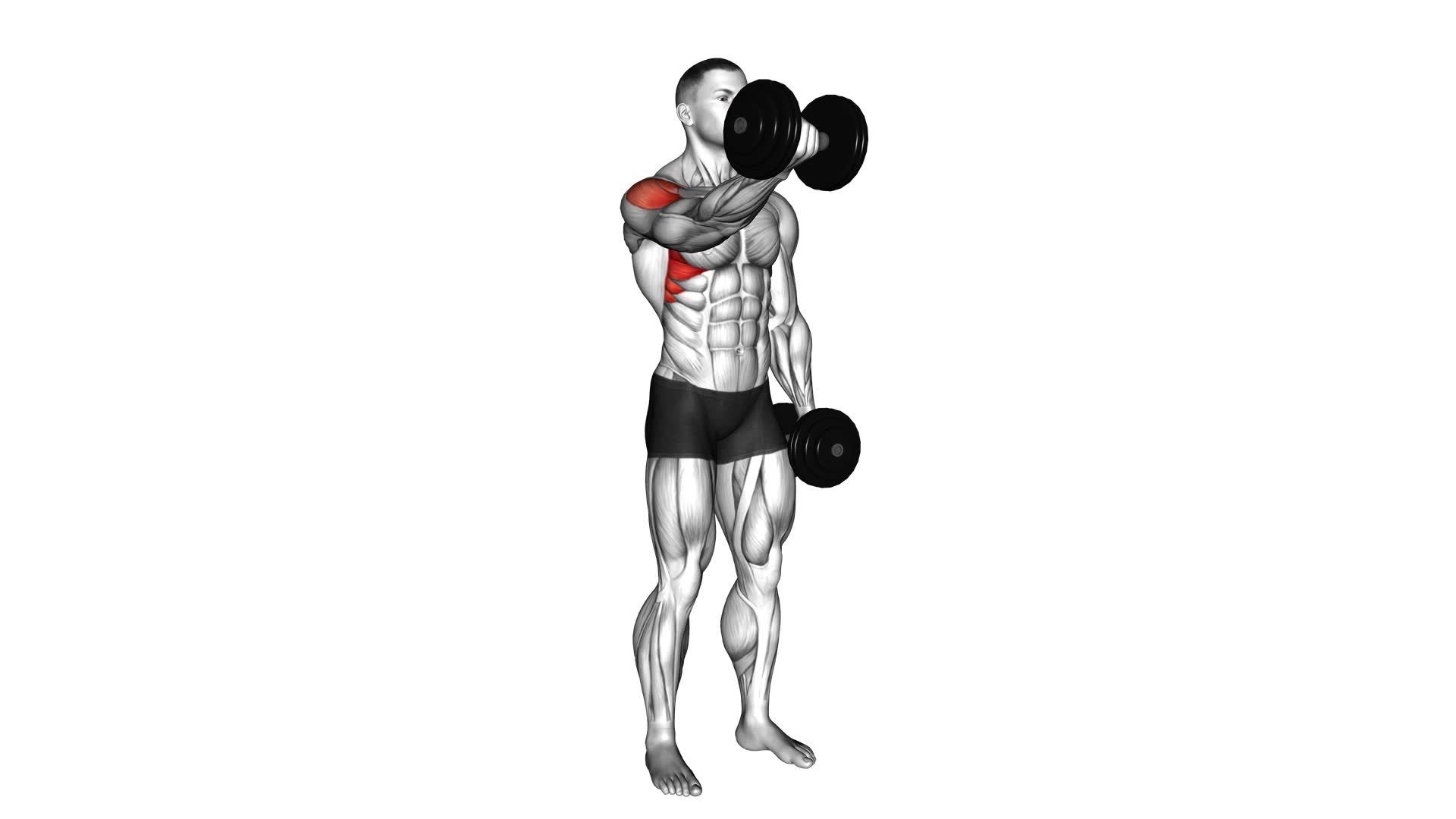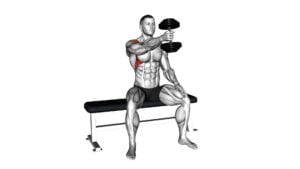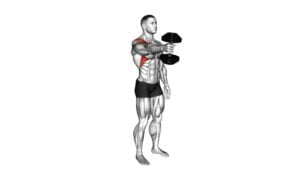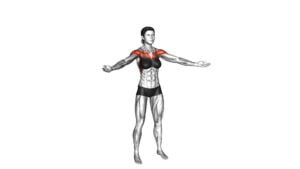Dumbbell Single Arm Underhand Front Raise – Video Exercise Guide & Tips

In this video exercise guide, you'll learn all about the Dumbbell Single Arm Underhand Front Raise. Discover the benefits of this effective shoulder workout and get expert tips on proper form and technique.
Watch This Exercise Video
Find out the recommended equipment and dumbbell weight for optimal results. Advanced users can explore variations and progressions to take their workout to the next level.
Avoid common mistakes and maximize your shoulder gains with these expert tips. Let's get started!
Key Takeaways
- Targets and strengthens shoulder muscles
- Improves shoulder stability and mobility
- Increases overall shoulder strength
- Engages muscles of the upper back and core for added stability
Benefits of the Dumbbell Single Arm Underhand Front Raise
You can achieve stronger shoulders by regularly performing the dumbbell single arm underhand front raise. This exercise is a great addition to your dumbbell exercises routine and is specifically designed to target and strengthen your shoulder muscles. By holding a dumbbell in one hand with an underhand grip and raising it up in front of you, you engage the anterior deltoid muscles in your shoulders. This movement helps to improve shoulder stability and mobility, while also increasing overall shoulder strength.
The dumbbell single arm underhand front raise is an effective shoulder strengthening exercise because it isolates the shoulder muscles and allows for a full range of motion. This exercise also engages the muscles of the upper back and core, providing additional stability and support. Regularly incorporating this exercise into your workout routine can help to improve your posture, enhance your athletic performance, and reduce the risk of shoulder injuries.
To perform the dumbbell single arm underhand front raise correctly, start with a light to moderate weight dumbbell and stand tall with your feet shoulder-width apart. Hold the dumbbell in one hand with an underhand grip, palm facing towards your body. Keeping your arm straight, lift the dumbbell up in front of you, stopping when your arm is parallel to the ground. Slowly lower the dumbbell back down to the starting position and repeat for the desired number of repetitions.
Proper Form and Technique for the Exercise
To perform the dumbbell single arm underhand front raise with proper form and technique, focus on maintaining a straight arm while lifting the dumbbell in front of your body. This exercise targets the front deltoids and helps to improve shoulder strength and stability. Start by standing tall with your feet shoulder-width apart, holding a dumbbell in one hand with an underhand grip. Keep your core engaged and your back straight throughout the movement.
As you lift the dumbbell, exhale and raise your arm directly in front of you, until it's parallel to the ground. Avoid any swinging or jerking motions and keep your arm straight throughout the exercise. It's important to control the weight and not let it drop back down. Pause for a second at the top of the movement and then slowly lower the dumbbell back down to the starting position.
Common mistakes to avoid include lifting the dumbbell too high, using momentum to lift the weight, and leaning backward. Remember to keep the movement controlled and focus on using your shoulder muscles to lift the weight, rather than relying on other body parts.
Incorporate these shoulder workout tips into your routine to maximize the effectiveness of the dumbbell single arm underhand front raise. By maintaining proper form and technique, you can safely and effectively target your front deltoids and improve your overall shoulder strength.
Equipment and Dumbbell Weight Recommendations
For optimal results, select an appropriate dumbbell weight for the dumbbell single arm underhand front raise exercise. The right equipment is crucial to ensure that you're effectively targeting the muscles and avoiding any potential injuries. When it comes to equipment recommendations, dumbbells are the go-to choice for this exercise. They offer a versatile and adjustable option that allows you to increase or decrease the weight as needed.
Now, let's talk about dumbbell weight guidelines. The weight you choose will depend on your fitness level and strength. Beginners should start with lighter dumbbells to focus on proper form and technique. A good starting point could be 5 to 10 pounds. As you progress and become more comfortable with the exercise, you can gradually increase the weight. Intermediate and advanced individuals may opt for heavier dumbbells, such as 10 to 20 pounds or even higher, depending on their strength and goals.
Variations and Progressions for Advanced Users
As an advanced user, you can challenge yourself by increasing the weight options for the dumbbell single arm underhand front raise. This will help to further strengthen and tone your shoulders and upper body.
Additionally, you can incorporate challenging movement patterns, such as performing the exercise on an unstable surface or adding a rotational component to the movement, to enhance the difficulty and engage more muscles.
Increasing Weight Options
Challenge yourself with advanced variations and progressions to increase the weight options for the Dumbbell Single Arm Underhand Front Raise exercise. Here are three ways to take this exercise to the next level:
- Different grip options: Experiment with using different grips during the exercise to target different muscles. For example, try a pronated grip (palms facing down) or a neutral grip (palms facing each other) to engage your muscles in different ways.
- Modifying the exercise for beginners: If you're just starting out or want to build up strength before attempting heavier weights, you can modify the exercise by using lighter dumbbells or even substituting them with resistance bands. This allows you to focus on proper form and gradually increase the intensity as you progress.
- Increasing weight gradually: As you become more comfortable with the exercise and your strength improves, gradually increase the weight of the dumbbell to continue challenging yourself. Start with small increments and listen to your body to avoid overexertion.
Challenging Movement Patterns
To further challenge yourself and continue progressing with the Dumbbell Single Arm Underhand Front Raise exercise, you can explore variations and progressions that involve more complex movement patterns. These challenging movement patterns not only target your shoulder muscles but also help improve coordination and overall body control.
One variation you can try is the Single Arm Underhand Front Raise with a Twist. Instead of raising the dumbbell directly in front of you, you twist your torso as you lift the weight, engaging your oblique muscles as well.
Another progression is the Single Arm Underhand Front Raise with a Lunge. This combines the shoulder exercise with a lower body movement, adding an extra challenge to your coordination and balance.
Common Mistakes to Avoid
When performing the dumbbell single arm underhand front raise, it's important to pay attention to your elbow positioning. Keeping your elbow slightly bent throughout the movement will help target the correct muscles and prevent strain.
Additionally, maintaining a strong grip on the dumbbell will ensure stability and control throughout the exercise.
Elbow Positioning Importance
Ensure proper elbow positioning during the dumbbell single arm underhand front raise to maximize the effectiveness of the exercise. The alignment of your elbows is crucial for optimal muscle activation and to prevent unnecessary strain on your joints.
Here are three common mistakes to avoid when it comes to elbow positioning:
- Elbows too bent: Keeping your elbows excessively bent can limit the range of motion and reduce the activation of the target muscles. Make sure to maintain a slight bend in your elbows throughout the movement.
- Elbows too straight: On the other hand, fully extending your elbows can put excessive stress on your joints, particularly the elbow joint. It's important to avoid locking out your elbows and maintain a soft, slightly bent position.
- Elbows too wide or narrow: Finding the right width for your elbows is crucial for targeting the correct muscles. Avoid flaring your elbows out to the sides or keeping them too close to your body. Instead, aim for a comfortable position where your elbows are in line with your shoulders.
Grip Strength and Stability
What are some common mistakes to avoid when it comes to grip strength and stability during the dumbbell single arm underhand front raise?
Grip strength exercises and shoulder stability training are essential for performing this exercise correctly and preventing injuries.
One common mistake is using a grip that's too tight, which can lead to muscle fatigue and limit your range of motion. It's important to find a balance between a firm grip and not overexerting your hand muscles.
Another mistake is neglecting your shoulder stability. Weak shoulder muscles can cause instability during the exercise, increasing the risk of injury. Incorporating shoulder stability exercises into your workout routine can help improve your grip strength and overall performance during the dumbbell single arm underhand front raise.
Tips for Maximizing Your Shoulder Workout Results
To optimize your shoulder workout results, incorporate high-intensity exercises. By pushing your shoulder muscles to their limits, you'll stimulate growth and maximize shoulder gains. Here are three of the best exercises for shoulder development:
- Overhead Press: This compound movement targets all three heads of the shoulder muscle and is a staple in any shoulder workout. Using a barbell or dumbbells, press the weight overhead while maintaining a strong core and stable lower body.
- Lateral Raises: This isolation exercise specifically targets the lateral head of the shoulder muscle. Hold dumbbells at your sides and raise them out to the sides until they're parallel to the ground. Focus on controlling the movement and engaging the shoulder muscles throughout.
- Rear Delt Flyes: This exercise targets the rear deltoids, which are often overlooked in shoulder workouts. Using dumbbells or cables, bend forward at the hips with a slight bend in the knees and raise the weights out to the sides, squeezing the shoulder blades together at the top of the movement.
Incorporating these high-intensity exercises into your shoulder workout routine will help you achieve the shoulder gains you desire. Remember to always use proper form and start with lighter weights before increasing the intensity.
Frequently Asked Questions
How Many Reps and Sets Should I Do for the Dumbbell Single Arm Underhand Front Raise?
To determine the number of reps and sets for the dumbbell single arm underhand front raise, you need to consider your fitness goals and current strength level.
However, a good starting point is to perform 3 sets of 8-12 reps with each arm.
This exercise targets the front deltoids, biceps, and forearms. It helps improve shoulder stability, posture, and overall upper body strength.
Remember to maintain proper form and technique throughout the movement for optimal results.
Can I Do the Exercise With a Resistance Band Instead of Dumbbells?
Yes, you can definitely do the dumbbell single arm underhand front raise exercise with a resistance band instead of dumbbells. Resistance band modifications are a great way to add variety to your workout routine.
Using resistance bands can help improve muscle strength, flexibility, and stability. They also provide constant tension throughout the movement, which can be beneficial for muscle growth.
Is the Dumbbell Single Arm Underhand Front Raise Suitable for Beginners?
As a beginner, you may wonder if the dumbbell single arm underhand front raise is suitable for you. This exercise can be challenging for beginners due to its focus on shoulder and upper body strength. However, there are alternatives to consider.
A beginners guide to dumbbell exercises can provide you with a range of options that are more suitable for your fitness level. Remember to start with lighter weights and gradually increase as you build strength and confidence.
How Can I Modify the Exercise if I Have Shoulder Pain or Injury?
If you're experiencing shoulder pain or have a shoulder injury, it's important to modify the exercise to avoid further discomfort.
Instead of the dumbbell single arm underhand front raise, you can try alternative exercises that put less strain on your shoulders.
For example, you could do lateral raises with lighter weights or use resistance bands to target your shoulder muscles.
Remember to listen to your body and consult with a professional if needed.
Can I Incorporate the Dumbbell Single Arm Underhand Front Raise Into a Full-Body Workout Routine?
To incorporate the dumbbell single arm underhand front raise into a full-body workout routine, you can perform it as part of your upper body or shoulder day. This exercise targets your shoulders, biceps, and upper back.
To modify it for different fitness levels, you can adjust the weight or the number of repetitions. Remember to maintain proper form and listen to your body to avoid any shoulder pain or injury.
Always consult with a fitness professional if you have any concerns.
Conclusion
Incorporating the dumbbell single arm underhand front raise into your shoulder workout routine can provide numerous benefits, including improved shoulder strength and stability.
By following proper form and technique, using the appropriate equipment and weight, and avoiding common mistakes, you can maximize the effectiveness of this exercise.
For advanced users, variations and progressions are available to further challenge your shoulders.
Remember to always prioritize safety and consult with a fitness professional if needed.
Keep up the great work and enjoy the results of your shoulder workout!

Author
Years ago, the spark of my life’s passion ignited in my mind the moment I stepped into the local gym for the first time. The inaugural bead of perspiration, the initial endeavor, the very first surge of endorphins, and a sense of pride that washed over me post-workout marked the beginning of my deep-seated interest in strength sports, fitness, and sports nutrition. This very curiosity blossomed rapidly into a profound fascination, propelling me to earn a Master’s degree in Physical Education from the Academy of Physical Education in Krakow, followed by a Sports Manager diploma from the Jagiellonian University. My journey of growth led me to gain more specialized qualifications, such as being a certified personal trainer with a focus on sports dietetics, a lifeguard, and an instructor for wellness and corrective gymnastics. Theoretical knowledge paired seamlessly with practical experience, reinforcing my belief that the transformation of individuals under my guidance was also a reflection of my personal growth. This belief holds true even today. Each day, I strive to push the boundaries and explore new realms. These realms gently elevate me to greater heights. The unique combination of passion for my field and the continuous quest for growth fuels my drive to break new ground.







